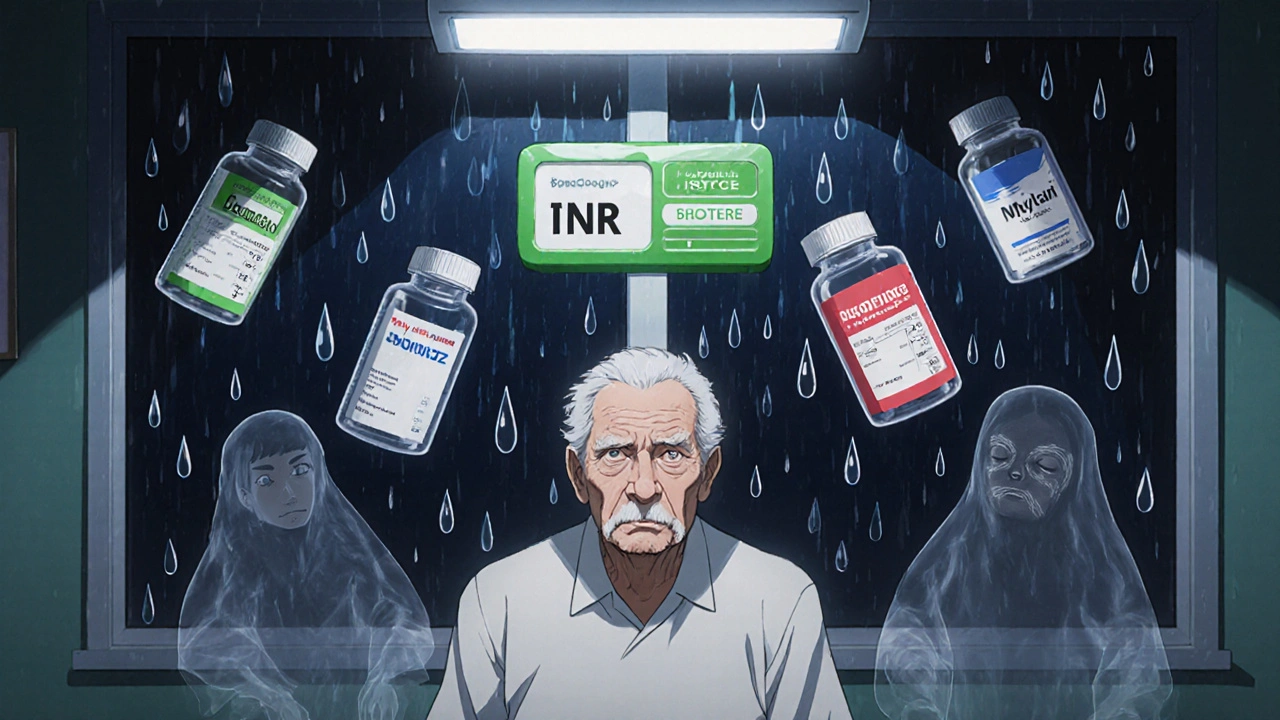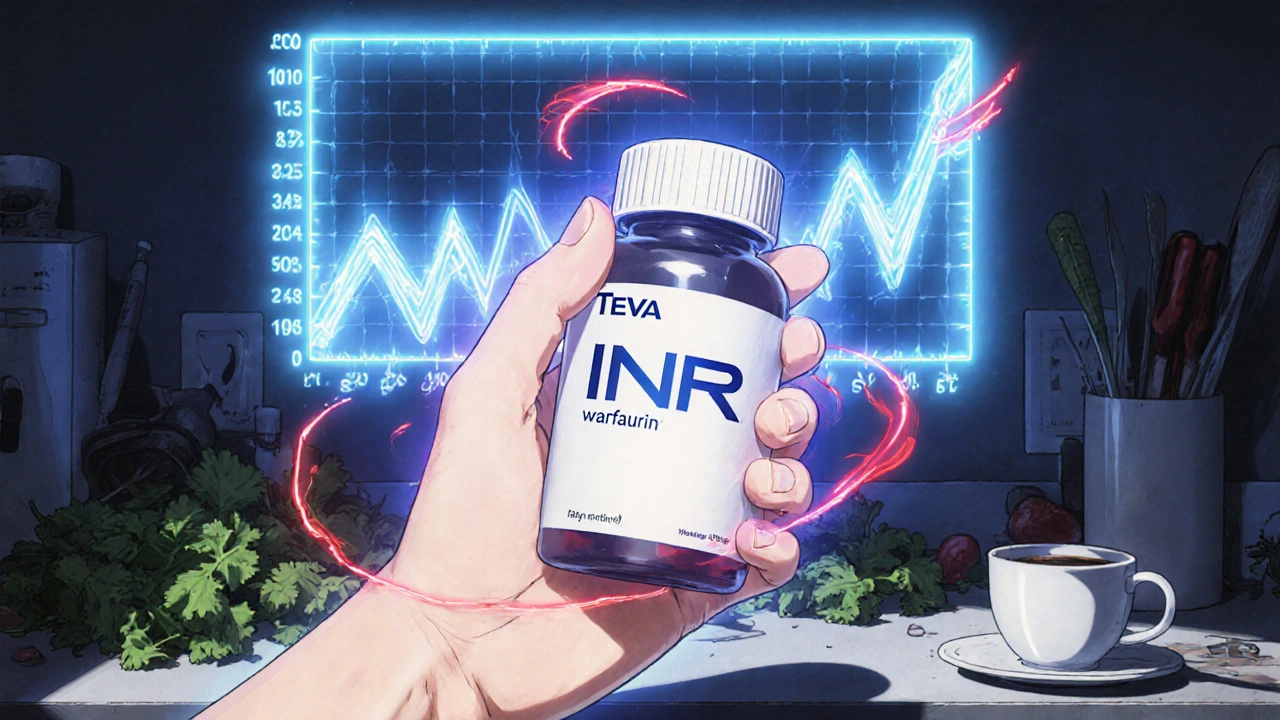Switching from brand-name Coumadin to a generic version of warfarin sounds simple-cheaper, same drug, right? But for people on warfarin, this switch isn’t just a pharmacy change. It’s a potential trigger for dangerous swings in blood clotting risk. Even though the FDA says all approved warfarin generics are "therapeutically equivalent," real-world experience shows that warfarin doesn’t behave like most other medications when you switch brands.
Why Warfarin Is Different
Warfarin isn’t like taking a generic ibuprofen. It has a narrow therapeutic index, meaning the difference between a safe dose and a dangerous one is tiny. Your target INR (International Normalized Ratio) is usually between 2.0 and 3.0. Go below 2.0, and you’re at risk for a stroke or blood clot. Go above 3.0, and you could bleed internally-sometimes without warning.This isn’t theoretical. In 2010, the FDA added a "black box" warning to warfarin labels after reviewing thousands of hospitalizations linked to bleeding. A 12-month study of nursing home residents found that 720 adverse events occurred among just 3,000 people on warfarin. About one in six of those patients had an event that could have been prevented with better monitoring.
Why is this drug so finicky? Warfarin is broken down in the liver by enzymes (CYP2C9 and CYP3A4), and even small changes in how it’s absorbed can throw off your INR. That’s why switching from one generic manufacturer to another-even if both are FDA-approved-can cause your INR to jump or drop unexpectedly.
What the Research Actually Shows
Several large studies have looked at whether switching to generic warfarin is safe. One major study followed 182 patients in a St. Louis HMO after they switched from Coumadin to a generic made by Barr Laboratories. The results? No significant change in INR control, no spike in clots or bleeds. Another review of 11 studies involving over 40,000 patients found that most switches didn’t cause major INR shifts.But here’s the catch: those studies looked at one generic brand. They didn’t test switching back and forth between multiple generics. And in real life, that’s exactly what happens. Pharmacies rotate suppliers based on cost. One month you get Teva, the next Mylan, then Sandoz. Each has slightly different fillers, binders, or manufacturing processes. For warfarin, those tiny differences matter.
One study found that 15-20% of patients had noticeable INR changes within the first few weeks after switching. Most of those changes were minor, but a few led to dose adjustments, emergency visits, or hospitalizations. The American Heart Association says it plainly: switching between different generic manufacturers may introduce variability-and that variability needs watching.
When and How to Monitor After a Switch
If you’re switching from Coumadin to a generic-or from one generic to another-don’t assume everything’s fine. The standard advice for stable patients is to check INR every 4-6 weeks. That’s not enough after a switch.Here’s what experts recommend:
- Check INR within 3-5 days after the switch.
- Check again in 7-10 days.
- Continue checking every 3-7 days for the next 2-4 weeks.
- Only return to monthly checks once your INR has been stable for at least two consecutive tests.
Some clinics, like the Cleveland Clinic, even recommend daily or every-other-day INR tests during the first week if the patient has a history of unstable INRs or is elderly. That might sound extreme, but for someone with a mechanical heart valve or a history of clots, it’s not.
And don’t forget to tell your doctor or anticoagulation clinic exactly which generic you got. Write down the manufacturer name on your pill bottle or pharmacy receipt. If your INR suddenly drops, they’ll need to know if you switched brands.

What Else Can Throw Off Your INR?
Warfarin is sensitive to more than just brand changes. A lot of things can mess with your INR-sometimes without you realizing it.- Diet: Vitamin K (found in kale, spinach, broccoli, and Brussels sprouts) directly counteracts warfarin. A sudden increase in leafy greens-even just one big salad-can make your INR drop. The same goes for cranberry juice, grapefruit, and alcohol.
- Other medications: Over 300 drugs interact with warfarin. Antibiotics like trimethoprim-sulfamethoxazole, painkillers like ibuprofen, even some herbal supplements like garlic or ginkgo can spike your INR. Always check with your pharmacist before starting anything new.
- Adherence: Missing doses or taking extra pills is a leading cause of INR instability. Studies show 15-30% of warfarin patients don’t take it exactly as prescribed.
- Laboratory errors: INR results can vary between labs. If your INR suddenly looks off and nothing else changed, ask if they used the same machine or reagent.
If your INR changes for no clear reason, don’t guess. Don’t adjust your dose yourself. Call your provider. Most will adjust your dose by 5-10% and retest in a week. That’s safer than trying to fix it on your own.
Why Do People Still Take Warfarin?
With all the hassle, why isn’t everyone switching to the newer DOACs (direct oral anticoagulants) like apixaban or rivaroxaban? Because warfarin still has unique advantages.- Cost: A month’s supply of generic warfarin costs $4-$10. DOACs? $300-$500.
- Reversibility: If you bleed badly, vitamin K or fresh frozen plasma can reverse warfarin in hours. DOACs have reversal agents, but they’re expensive and not always available.
- Long-term use in specific cases: For people with mechanical heart valves-especially mitral valves-warfarin is still the gold standard. DOACs don’t work as well here.
- Renal issues: If your kidneys are failing, many DOACs aren’t safe. Warfarin is cleared by the liver, so it’s often the only option.
In 2022, over 1.2 million Medicare beneficiaries were still on warfarin. That’s not because they’re stuck with it-it’s because it’s the best tool for their situation.

What You Should Do Right Now
If you’re on warfarin, here’s your action plan:- If you’ve recently switched generics, check your INR within 5 days.
- Keep a log: Write down the name of the generic (Teva, Mylan, etc.) and the lot number if you can find it.
- Don’t change your diet suddenly. Keep your vitamin K intake consistent.
- Always tell every doctor or pharmacist you see that you’re on warfarin-even for a cold or a tooth extraction.
- If your INR is out of range and you can’t explain why, ask if you switched manufacturers.
And if you’re thinking about switching from warfarin to a DOAC? Talk to your doctor. For some people, it’s the right move. For others, the cost and lack of reversibility make warfarin the smarter long-term choice.
Bottom Line
Generic warfarin is safe for most people-but only if you treat it like the high-risk medication it is. Don’t assume it’s just like any other generic. The FDA says they’re equivalent. Real doctors know that’s not the whole story.For warfarin, consistency matters more than cost. If your INR has been stable for years on Coumadin, switching to a generic might not be worth the risk. If you’re starting warfarin now, a generic is fine-but expect tighter monitoring at first.
Warfarin isn’t going away. It’s too cheap, too effective for certain conditions, and too reversible. But it demands respect. The right monitoring, the right communication, and the right awareness can turn a dangerous drug into a life-saving one.
Can I switch between different generic warfarin brands safely?
Switching between different generic warfarin brands can cause changes in your INR, even if both are FDA-approved. While many people switch without issues, 15-20% experience noticeable fluctuations. Always check your INR within 3-5 days after switching and continue frequent monitoring for 2-4 weeks. Keep track of the manufacturer name and lot number on your prescription bottle.
How often should I check my INR after switching to a generic?
After switching to a generic warfarin, check your INR within 3-5 days, then again in 7-10 days. Continue checking every 3-7 days for the next 2-4 weeks. Only return to monthly checks once your INR has been stable for two consecutive tests. Some patients, especially those with mechanical valves or unstable INRs, may need daily checks during the first week.
Why does warfarin need more monitoring than other blood thinners?
Warfarin has a narrow therapeutic index, meaning small changes in dose or absorption can cause big changes in blood clotting. It’s affected by diet, other medications, liver function, and even the specific generic formulation you’re taking. Newer blood thinners (DOACs) don’t require regular blood tests because their effects are more predictable and less influenced by these factors.
What should I do if my INR suddenly goes up or down?
Don’t adjust your dose yourself. Call your doctor or anticoagulation clinic immediately. They’ll check for common causes: did you switch generics? Did you start a new medication? Did you eat more leafy greens? If no cause is found, they’ll likely adjust your dose by 5-10% and retest in a week. Never ignore a sudden INR change-it could be a sign of bleeding or clotting risk.
Is warfarin still the best option for mechanical heart valves?
Yes. For mechanical heart valves-especially mitral valves-warfarin is still the recommended anticoagulant. Studies show DOACs are less effective at preventing clots in these patients and carry higher bleeding risks. Warfarin’s ability to be reversed quickly with vitamin K or plasma makes it the safer choice in emergency situations for valve patients.
Can I switch from warfarin to a DOAC to avoid regular blood tests?
It’s possible, but not always better. DOACs don’t require INR monitoring, which is convenient. But they’re 30-50 times more expensive, can’t be reversed as easily in emergencies, and aren’t safe for people with severe kidney disease or mechanical heart valves. Talk to your doctor about your health, cost, and lifestyle. For many, the cost and reversibility of warfarin make it the better long-term choice.

Kimberley Chronicle
November 25, 2025 AT 23:11Just had my INR spike to 4.8 after switching from Coumadin to Teva generic-no dietary changes, no new meds. Turns out the pharmacy rotated suppliers without telling me. The 3-day post-switch INR check saved me from a potential bleed. If you're on warfarin, treat every generic switch like a new prescription. Document the manufacturer. Write it on your hand if you have to. This isn't pharmacology-it's survival math.
Shirou Spade
November 27, 2025 AT 13:58It’s funny how we treat warfarin like a glitch in the system when it’s actually a mirror. It reflects our arrogance-that we can reduce life-saving medicine to a cost-per-pill metric. The body doesn’t care about FDA equivalence. It cares about consistency, rhythm, the quiet dignity of routine. A pill is never just a pill. Especially not when your blood is learning to dance on a knife’s edge.
prasad gaude
November 29, 2025 AT 01:31Bro in India, we get warfarin from 5 different makers in a year-Teva, Mylan, Sun, Dr. Reddy’s, Cipla. My INR went from 2.3 to 4.1 in 72 hours after switching to a new batch. I started keeping a notebook: date, dose, manufacturer, lot number, INR. My doctor calls it ‘warfarin diary.’ I call it my lifeline. If you’re not tracking this stuff, you’re gambling with your organs.
Srikanth BH
November 29, 2025 AT 02:12Hey, if you’re on warfarin, don’t panic-just get smart. The key isn’t avoiding generics-it’s staying on top of your monitoring. Set phone alarms for INR checks. Tell your pharmacist you’re switching and ask them to note the brand. Most clinics will do a free INR check after a switch if you ask. You’ve got this. Small steps, big saves.
Jennifer Griffith
November 30, 2025 AT 07:29why do ppl even take warfarin?? like its 2005. just switch to Xarelto already. its like 500 bucks a month but at least i dont have to poke my finger every week. also i hate needles. like why is this even a thing??
Pallab Dasgupta
November 30, 2025 AT 11:33Y’all act like warfarin is some ancient curse-but it’s the only thing keeping my dad alive after his mechanical mitral valve. He’s 78. His INR’s been stable for 12 years on Coumadin. Last month, the pharmacy switched him to Mylan without telling us. He got dizzy, almost passed out. Turned out his INR was 5.2. We rushed him. He’s fine now. But this isn’t ‘generic vs brand’-this is life or death with a price tag. If your pharmacy rotates suppliers without warning? That’s not capitalism. That’s negligence.
Ellen Sales
December 1, 2025 AT 03:46So… the FDA says they’re equivalent… but every single time you switch, your body throws a tantrum? That’s not equivalence. That’s a loophole. A bureaucratic fiction. We’ve turned medicine into a commodity, and now we’re surprised when the machine breaks down? Warfarin isn’t broken. We are. We’ve forgotten that some things can’t be optimized. Some things need reverence. Not coupons.
Josh Zubkoff
December 2, 2025 AT 09:19Look, I get it. Warfarin’s a pain. But let’s be real-this whole ‘generic switch’ panic is just a symptom of a broken healthcare system where pharmacists are incentivized to cut costs, not save lives. The FDA’s ‘therapeutic equivalence’ label is a joke when you have 15-20% of patients swinging INR like a pendulum. And don’t even get me started on the fact that the same pill made in a factory in India, with different fillers, gets stamped ‘FDA approved’ while we’re all supposed to just trust the system. This isn’t medicine. It’s a lottery. And your blood is the ticket.
fiona collins
December 2, 2025 AT 15:04Check INR 3-5 days after switch. Then 7-10. Then weekly for a month. Log the brand. Tell your provider. That’s it. No drama. No panic. Just protocol.
giselle kate
December 3, 2025 AT 07:48Why are we still using this 1950s drug? America’s healthcare system is broken because we let corporations decide what’s ‘good enough.’ DOACs exist. They’re safer. They’re easier. But because they’re expensive, we force elderly people to poke their fingers daily just to save Big Pharma a few bucks. This isn’t healthcare. It’s exploitation dressed in white coats.
Emily Craig
December 5, 2025 AT 01:16Ohhh so now warfarin’s the OG blood thinner and we’re all supposed to be like ‘ooh ahh’ because it’s cheap?? Sweetie, I’ve been on Xarelto for 5 years. No finger pricks. No dieting. No pharmacy roulette. And I didn’t die. Maybe the real problem isn’t warfarin… it’s that we’re still romanticizing the past while people bleed out because someone didn’t check a bottle label. Just sayin’.